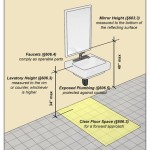Best Paint Colors for a Small Bathroom With No Windows
Selecting the right paint color for a small bathroom lacking natural light can significantly impact the perceived size and atmosphere of the space. These rooms often feel cramped and dark, so choosing the right hue is crucial to creating a more open, airy, and inviting environment. The objective is to maximize the available light, even artificial, and make the bathroom appear larger than its physical dimensions suggest. This article will explore various paint color options and their effects on the overall aesthetic of a small, windowless bathroom.
The absence of natural light in a small bathroom presents unique challenges. Unlike larger bathrooms with windows, these spaces rely entirely on artificial lighting, which can sometimes cast harsh shadows and amplify any feelings of confinement. A thoughtfully selected paint color can counteract these effects by reflecting light, creating visual depth, and establishing a sense of spaciousness.
Understanding Light Reflectance Value (LRV)
Light Reflectance Value, or LRV, is a measurement used to determine the percentage of light a color reflects. It ranges from 0 to 100, with 0 representing absolute black (absorbing all light) and 100 representing pure white (reflecting all light). For small, windowless bathrooms, it is generally advisable to choose paint colors with high LRV values. These colors reflect light effectively, brightening the space and making it feel larger.
When considering paint colors, examine the LRV of the specific shade. Paint manufacturers often provide this information. Aim for options with an LRV of 60 or higher to maximize light reflection. Keep in mind that the perception of color can vary depending on the type and intensity of the artificial lighting used in the bathroom.
While high LRV values are generally preferred, the specific texture and sheen of the paint also play a role. Glossier finishes reflect more light than matte finishes, but they can also highlight imperfections in the walls. Eggshell or satin finishes often strike a good balance between light reflection and concealing minor wall defects.
Optimal Color Palettes for Small, Windowless Bathrooms
Several color families are particularly well-suited for small bathrooms without windows. These colors tend to be light, airy, and reflective, contributing to a more open and inviting atmosphere. The following colors represent commonly utilized choices for brightening and expanding the space.
Whites and Off-Whites: White is a classic choice for small spaces due to its exceptional light-reflecting properties. Different shades of white, such as warm whites with yellow undertones or cool whites with blue undertones, can create different moods. Off-whites, like cream or ivory, can add a touch of warmth without sacrificing brightness. However, it is crucial to select the right white shade that complements the artificial lighting in the bathroom to avoid a sterile or clinical feel. Too cool a white might make the room feel stark and unwelcoming, whilst too warm a white may appear yellow. A balanced white is paramount.
Light Grays: Soft, light grays can provide a sophisticated and calming backdrop. They offer a subtle alternative to white while still reflecting a significant amount of light. Gray with warm undertones, such as greige (gray-beige), can prevent the space from feeling cold and sterile. Opt for lighter shades of gray to maximize the light-enhancing effects.
Pastels: Light pastel shades, such as pale blues, greens, or lavenders, can introduce a touch of color without overwhelming the space. These colors tend to be calming and serene, creating a spa-like atmosphere. Ensure that the chosen pastel shade has a high LRV to maintain brightness. Pale blue can mimic the sky, giving the illusion of openness, whilst pale green can evoke nature and freshness.
Light Yellows: Soft, buttery yellows can bring a sense of warmth and sunshine to a windowless bathroom. They reflect light well and create a cheerful ambiance. Avoid overly saturated yellows, as they can be overwhelming in a small space. Subdued, pastel yellows are generally the most effective choice.
Choosing Accent Colors and Features: While lighter colors are generally recommended for the walls, carefully chosen accent colors can add visual interest and personality to the bathroom. These can be introduced through accessories, towels, artwork, or even a painted vanity. Consider using complementary colors or shades that contrast subtly with the wall color to create a balanced and visually appealing space. Darker accent colors should be used sparingly to avoid making the room feel smaller.
Strategies for Maximizing Light and Creating Visual Space
In addition to selecting the right paint color, several other strategies can enhance the sense of light and space in a small, windowless bathroom. These strategies focus on maximizing the available light, creating visual depth, and minimizing clutter.
Optimize Artificial Lighting: Since natural light is absent, adequate and well-placed artificial lighting is essential. Use a combination of overhead lighting, vanity lighting, and accent lighting to illuminate the entire space evenly. Consider using light bulbs with a high color rendering index (CRI) to accurately represent the colors in the room. Installing dimmers allows for adjusting the light intensity to suit different needs and moods. Consider integrated lighting solutions for mirrors or shelves to illuminate specific areas effectively.
Incorporate Mirrors: Mirrors are powerful tools for creating the illusion of space. A large mirror above the vanity can reflect light and visually double the size of the room. Consider installing mirrors on multiple walls to maximize the light-reflecting effect. Strategically placed mirrors can also reflect the light from artificial sources, further enhancing the brightness of the space. Mirrored cabinets are a practical and space-saving option.
Minimize Clutter: Clutter can make a small bathroom feel even smaller and more cramped. Keep countertops clear and organized by utilizing storage solutions such as shelves, cabinets, and drawers. Opt for minimalist décor and avoid overcrowding the space with unnecessary items. Streamlining the bathroom accessories and toiletries can significantly enhance the sense of spaciousness.
Use Vertical Space: Maximize the use of vertical space by installing tall, narrow shelves or cabinets. This can provide additional storage without taking up valuable floor space. Vertical stripes in wallpaper or paint can also create the illusion of height.
Choose the Right Materials: The materials used in the bathroom can also contribute to the overall sense of light and space. Consider using light-colored tiles or flooring to reflect light. Clear glass shower doors or enclosures can help to create a more open and airy feel. Reflective surfaces, such as chrome or stainless steel fixtures, can also enhance the brightness of the space. Avoid dark or heavy materials that can absorb light and make the room feel smaller.
Maintain a Clean and Bright Atmosphere: Regular cleaning and maintenance are crucial for keeping a small, windowless bathroom feeling fresh and inviting. Remove any mold or mildew promptly, as these can contribute to a damp and claustrophobic atmosphere. Ensure that the lighting fixtures are clean and functioning properly. A clean and well-maintained space will always feel more spacious and welcoming.
In conclusion, selecting the right paint color is a critical step in transforming a small, windowless bathroom into a more open, bright, and inviting space. By considering the LRV of the paint, opting for light and reflective colors, and implementing strategies to maximize artificial light and minimize clutter, it is possible to create a bathroom that feels significantly larger and more comfortable. The combination of strategic color choices, optimized lighting, and thoughtful design elements can overcome the challenges presented by the lack of natural light and create a bathroom that is both functional and aesthetically pleasing. The proper application of these techniques can dramatically alter the feel of a small bathroom, turning it from a potentially oppressive space into a tranquil and pleasant retreat.

13 Of The Best Paint Colors For Small Bathrooms Without Windows Explore Wall Decor

10 Best Paint Colors For Small Bathroom With No Windows Decor Home Ideas Choosing Colours Painting

10 Best Paint Colors For Small Bathroom With No Windows Decor Home Ideas

Best Paint Color For Small Bathrooms With No Windows Bathroom Colors

25 Best Paint Colors For Small Bathrooms Making Maanita

12 Best Paint Colors For A Small Bathroom Without Windows
:strip_icc()/cdn.cliqueinc.com__cache__posts__204742__the-best-small-bathroom-paint-colors-according-to-the-pros-1927576-1475690392.700x0c-f7b6a3fc126a4086ab44baa6cfa29003.jpg?strip=all)
The 7 Best Small Bathroom Paint Colors

13 Of The Best Paint Colors For Small Bathrooms Without Windows Explore Wall Decor

13 Of The Best Paint Colors For Small Bathrooms Without Windows Explore Wall Decor

10 Best Paint Colors For Small Bathroom With No Windows Decor Home Ideas







